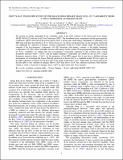| dc.contributor.author | Kalamkar, M. | |
| dc.contributor.author | Klis, M. van der | |
| dc.contributor.author | Heil, L. | |
| dc.contributor.author | Homan, Jeroen | |
| dc.date.accessioned | 2015-11-13T14:48:17Z | |
| dc.date.available | 2015-11-13T14:48:17Z | |
| dc.date.issued | 2015-07 | |
| dc.date.submitted | 2014-10 | |
| dc.identifier.issn | 1538-4357 | |
| dc.identifier.issn | 0004-637X | |
| dc.identifier.uri | http://hdl.handle.net/1721.1/99915 | |
| dc.description.abstract | We present an energy dependent X-ray variability study of the 2010 outburst of the black hole X-ray binary MAXI J1659–152 with the Swift X-ray Telescope (XRT). The broadband noise components and the quasi-periodic oscillations (QPO) observed in the power spectra show a strong and varied energy dependence. Combining Swift XRT data with data from the Rossi X-ray Timing Explorer, we report, for the first time, an rms spectrum (fractional rms amplitude as a function of energy) of these components in the 0.5–30 keV energy range. We find that the strength of the low-frequency component (<0.1 Hz) decreases with energy, contrary to the higher frequency components (>0.1 Hz) whose strengths increase with energy. In the context of the propagating fluctuations model for X-ray variability, we suggest that the low-frequency component originates in the accretion disk (which dominates emission below ~2 keV) and the higher frequency components are formed in the hot flow (which dominates emission above ~2 keV). As the properties of the QPO suggest that it may have a different driving mechanism, we investigate the Lense–Thirring precession of the hot flow as a candidate model. We also report on the QPO coherence evolution for the first time in the energy band below 2 keV. While there are strong indications that the QPO is less coherent at energies below 2 keV than above 2 keV, the coherence increases with intensity similar to what is observed at energies above 2 keV in other black hole X-ray binaries. | en_US |
| dc.language.iso | en_US | |
| dc.publisher | IOP Publishing | en_US |
| dc.relation.isversionof | http://dx.doi.org/10.1088/0004-637X/808/2/144 | en_US |
| dc.rights | Article is made available in accordance with the publisher's policy and may be subject to US copyright law. Please refer to the publisher's site for terms of use. | en_US |
| dc.source | IOP Publishing | en_US |
| dc.title | SWIFT X-RAY TELESCOPE STUDY OF THE BLACK HOLE BINARY MAXI J1659–152: VARIABILITY FROM A TWO COMPONENT ACCRETION FLOW | en_US |
| dc.type | Article | en_US |
| dc.identifier.citation | Kalamkar, M., M. van der Klis, L. Heil, and J. Homan. “SWIFT X-RAY TELESCOPE STUDY OF THE BLACK HOLE BINARY MAXI J1659–152: VARIABILITY FROM A TWO COMPONENT ACCRETION FLOW.” The Astrophysical Journal 808, no. 2 (July 28, 2015): 144. © 2015 The American Astronomical Society | en_US |
| dc.contributor.department | MIT Kavli Institute for Astrophysics and Space Research | en_US |
| dc.contributor.mitauthor | Homan, Jeroen | en_US |
| dc.relation.journal | The Astrophysical Journal | en_US |
| dc.eprint.version | Final published version | en_US |
| dc.type.uri | http://purl.org/eprint/type/JournalArticle | en_US |
| eprint.status | http://purl.org/eprint/status/PeerReviewed | en_US |
| dspace.orderedauthors | Kalamkar, M.; Klis, M. van der; Heil, L.; Homan, J. | en_US |
| mit.license | PUBLISHER_POLICY | en_US |
| mit.metadata.status | Complete | |
